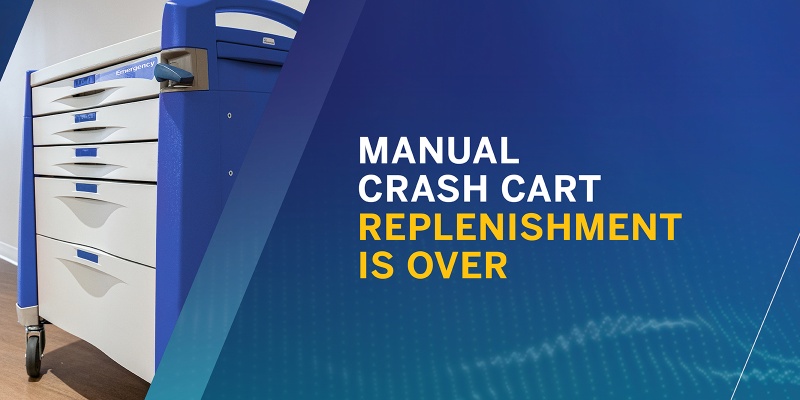
Rob Dewig, Vice President, Healthcare Solutions
In a 2022 report, the Joint Commission revealed a concerning trend: missing and expired items on crash or code carts ranked among the top 5 clinical problems found by surveyors. Shockingly, this isn’t a new issue. The Joint Commission highlighted similar concerns back in 2017, indicating that incomplete or improperly supplied emergency carts continue to pose significant risks to patient safety. Despite years of awareness, little progress has been made in addressing this critical issue.
Persistent Challenges
The 2017 report wasn’t revelatory news either. It was built on Pennsylvania Patient Safety Authority findings from over a decade earlier, revealing 56 reports of missing or outdated emergency supplies/equipment in a single year. These issues, ranging from medication errors to drained batteries, continue to persist in clinical settings, underscoring the long-standing nature of the problem and highlighting a systemic issue that demands urgent attention. Despite increased awareness, the root causes of cart deficiencies have yet to be effectively addressed, indicating a need for comprehensive solutions that go beyond surface-level fixes.
Manual Replenishment Woes
The labor-intensive process of manually restocking crash carts not only drains valuable staff resources but also introduces the potential for human error at every step. It takes 45 minutes to an hour for the central supply department to restock a single cart; the pharmacy department requires an additional 10-15 minutes, at least, per tray. All in all, even in the best case scenario, that means manual replenishment of a single cart takes well over an hour. With each nursing unit maintaining its own requirements for each type of cart — sometimes including specialized carts — that workload multiplies, creating inefficiencies that bottleneck the crash cart process in every department.
Impact on Cost and Patient Safety
The inefficiency of the industry’s current cart process exacts a dual toll on hospital resources and patient well-being. Firstly, the labor-intensive nature of manual restocking translates into significant costs in terms of staff time and wages. Hospital personnel spend valuable hours replenishing carts, diverting their attention from essential patient care tasks. Secondly, the reliance on manual processes heightens the risk of errors and omissions, compromising patient safety and exposing healthcare facilities to costly repercussions. Instances of missing or expired items on these carts not only jeopardize patient outcomes but also impact hospital ratings, such as Leapfrog Safety Grades and Centers for Medicare & Medicaid Services (CMS) star ratings. The resulting decline in quality and safety metrics can tarnish the hospital’s reputation and lead to financial penalties.
Pandemic Pressure
The strain placed on hospitals during the pandemic further highlighted the critical need for streamlined processes — especially processes resilient enough to help facilities adapt to staff shortages. As healthcare workers grappled with increased demand and limited resources, cart replenishment was backlogged, posing significant risk to patients. This risk underscored the urgent need for innovative crash cart management solutions. Forward-thinking health systems are now taking proactive measures to enhance preparedness for future emergencies.
Overdue Innovation
While automated dispensing systems have become typical for scheduled medications and, for some health systems, the pharmaceutical trays in emergency carts, the oversight of non-pharmaceutical cart inventory remains a pen-and-paper relic of the past. Management of these lower drawer supplies, though equally vital in an emergency, has lagged behind. It’s unclear why the healthcare industry has ignored or been reluctant to modernize code cart management with a more comprehensive approach, but failing to leverage available technology to its fullest potential has been a missed opportunity — both in reducing labor costs and mitigating risk. The transparency and efficiency that’s become so standard for medication management should be standard for the management of all cart items.
Towards a Safer Future
Moving forward, hospitals need to invest in technology-driven solutions that offer real-time visibility and promising avenues for improved efficiency. Addressing cart challenges goes beyond inventory management. Medical facilities should make sure the right items are stocked, properly dated, and readily available. Reducing human error must be equally prioritized.
It’s clear that the status quo of emergency cart management is no longer acceptable. Hospitals must embrace innovation for holistic cart management to safeguard patient well-being and mitigate preventable risks. By investing in modern technologies and processes, healthcare facilities can proactively manage cart inventory and anticipate needs, ensuring that crash carts are always ready for those life saving situations where every second counts.
Learn more about Inmar’s medication and supplies tracking solutions
Contributions from Hunter McOwen, Inmar Healthcare
